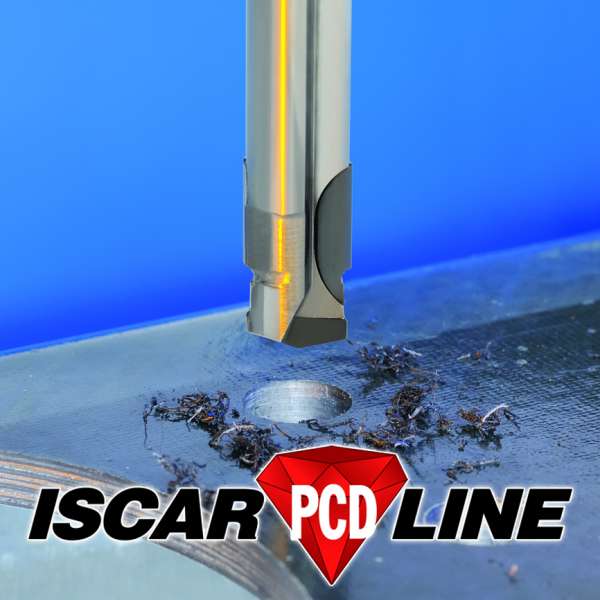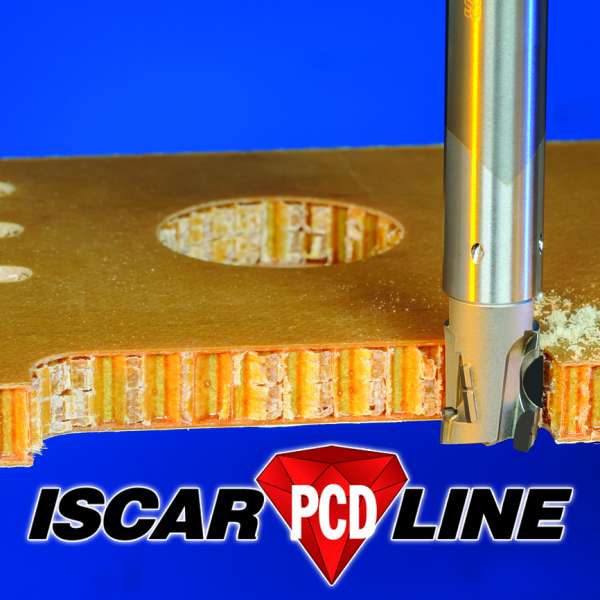Lighter and stronger than ever, the new breed of carbon fiber reinforced plastics (CFRP) and laminates are elevating performance levels in applications ranging from downhill skis and tennis rackets to military aircraft and automobiles. Composites technology can help automakers reach their lightweighting goals faster than carbon fiber-reinforced plastics.
As a workpiece material, however, their main impact has been to elevate the manufacturing challenges, especially machining. While superb in airframes or marine vessel frames, types of fiber-reinforced epoxy, polyester and vinyl are harder on tools and less forgiving of even small vagaries in processing. Moreover, their higher added value pre-machining leaves even less tolerance for scrap.
Fortunately, a new generation of cutting tools is emerging that is tailored specifically to perform the most frequently required operations on all types of advanced composites. For instance, Iscar’s PCD LINE of drills and milling cutters. There are drills suited for thicker materials with aluminum on the bottom, as well as for thinner materials with the CFRP on the bottom. There are combination drill-countersinks and drill-reamers, slotting cutters and combination mill/drill cutters. The bottom line is, that possibly for the first time since reinforced composites came on the scene, you can find a no-compromise tool for any conceivable composite machining task.
Presently the cutting tool material of choice for composites is a solid carbide shank with thin PCD coatings, brazed-in PCD inserts or PCD veins at the cutting edge. In literally thousands of applications on virtually every advanced composite, Iscar says this type of tool has outperformed all others, including CVD diamond coated solid carbide. The harder and more highly reinforced the material, the greater the margin of improvement.
The reasons are clear. The solid carbide shank provides the rigidity and dimensional accuracy necessary to maintain close tolerances on size and location as well as smooth surfaces. Solid carbide also makes it possible to start with an optimal cutting geometry that minimizes cutting forces, heat, uncut fibers, cups, fuzz and burrs while controlling chips. The thin PCD coating (or insert) provides the wear resistance at the cutting edge to maintain that optimal geometry over long service intervals.
Note the emphasis on thin PCD coatings. They deliver the wear resistance of diamond while preserving the ideal cutting geometry machined into the carbide shank. By contrast, CVD (chemical vapor deposition) inevitably creates a thicker diamond layer that may detract from optimal geometry.
Whatever the application, there are a few principles to keep in mind when machining CFRPs or other stacked materials.
Hole Making, Close Up
Hole making, mainly for rivet holes, is a mainstay process in composites work, and very unforgiving. Because of their inherent hardness and dimensional stability, FRP composites don’t readily resolve misalignment stresses introduced during fabrication by off-center rivet holes.
Early solutions centered on orbital drilling on CNC machines with offset and interpolation programming capabilities, using solid carbide tools. This is actually an orbital milling process, not true drilling, which uses a tool smaller in diameter than the hole. The process does run cooler and reduces thrust forces compared with drilling. It also enables a single tool to produce different diameter holes and irregular cavities, which reduces tool inventory costs.
Tool wear remained a problem, however, leading to a common “workaround”: programmed tool wear compensation. While this strategy maintained dimension, it did nothing for surface finish or heat management.
Diamond Carbide Tools
Diamond-enhanced solid carbide drills described earlier have proven very successful, as they stay sharper longer than plain solid carbide tools in composites machining service.
Four styles of diamond-enhanced tools are now available for composites machining:
CVD Diamond Carbide combines the wear resistance of diamond and the dimensional accuracy of solid carbide. The downside is that the coating is inherently thick, which can detract from sharpness and geometry right at the cutting edge. PCD Coated Solid Carbide offers the same advantages plus better sharpness and geometry control at the cutting edge. PCD Brazed-in Inserts in Solid Carbide Shanks are suitable where diamond’s wear resistance is needed only at the leading edge. PCD-Veined Solid Carbide features “veins” of PCD bonded into grooves machined into the carbide shank.
One recent innovation for composites and stack drilling is Iscar’s new head for the Multi-Master line. The system features no setup time, providing the ability to mount very quickly and easily, a variety of changeable heads on one shank, claims Iscar. The new head is comprised with PCD cutting edges and composite-optimized geometries. The heads perform roughing, semi-finishing and finishing operations in sequence. This geometry enables opening of cavities and slots and performing shoulder applications. Since the shank is thinner than the cutting tip, contact and friction with walls is reduced, so the operation runs cooler.
Iscar says its SolidDrill-REAM, is another option, a combination drill and reamer for producing more accurate holes in a single step. Separate brazed-in PCD inserts on the same shank handle the drilling and reaming.
Improving Hole Making
That said, here are some tips for improving or troubleshooting a hole making operation in composites:
Keep cutting forces light to minimize delamination and stress on the material.
In aluminum honeycomb or foam core, solid carbide drills will likely suffice.
Iscar’s new ICF drilling heads geometry for CFRP and CFRP laminates drilling. This geometry combines small point angles and positive rakes. This provides low axial forces for smooth penetration during the cutting process without splintering phenomenon which is critical on thin-wall workpieces. The new heads are produced in the new grade IC107 which combines IC07 hard submicron substrate and CVD diamond coating for prolonged and predictable tool life. SumoCham for composites is suitable to be used on CNC or PKM (Parallel Kinematic Machines) machines. For robots and powered feed machines, a special connector is available. The fast head replacement and high positioning repeatability provide minimum machine downtime.
Relatively small indexable drilling heads with diamond coating provide a real price advantage compared to long full solid carbide drills, as well as easy stock management.
The harder the matrix and higher the reinforcing fiber content, the more you will need PCD coatings/inserts at the cutting edge.
When hole size allows it, orbital drilling with a solid carbide endmill or milling interpolation using the MULTI-MASTER with PCD coated tips is preferable to straight twist drilling.
For shallower holes, use stubby, straight-shank drills. For deeper holes, design the process for absolutely reliable ejection of all types of chip. Consider “peck drilling ” and even coolant flushing, if possible.
Match speeds and feed to the layers in the laminate. Be ready to change parameters for each layer as the drill progresses.
Select the tool geometry based on the last material in the stack. If a plastic, use a tapered drill with a long point angle. If the last layer is aluminum or titanium, a high-shear drill with a sharp point angle will exit more cleanly and leave less burr. The tapered drill would just smear aluminum.
In thicker composite structures, beware of heat buildup as well as chip jamming. Select drills with narrow flutes, wide gullets and tighter spirals that complete the hole before things get too hot and in addition consider coolant.
What About Titanium?
When titanium is in the stack, the preferred practice is everything that composites hate. To avert work hardening and overheating and to keep chips controllable, select tools with low reliefs and rake angles and a low spindle speed. Although coolant or mist is not generally used, it may be unavoidable for titanium because of the heat and/or chip flushing.
In short, take everything into account in tool selection, including the relative thicknesses and location of the metal and plastic layers. It is a balancing act. A stack heavy toward the metal favors solid carbide tools with internal coolant. If CFRP is the main part, PCD carbide tools would be preferable.
Be sure the process reliably breaks up the titanium chips into small, easily ejected pieces. You especially don’t want to risk a titanium chip jamming the hole in a composite. Again, the most effective remedies are slower speeds and pecking cycles.
Composite Milling
Milling composites, as for drilling, is equally challenging. If the tool encounters several different layers at the same time, you need to engineer the process, taking all limitations into account. If you are progressing through the layers pass by pass, you may have to change parameters to match the layer.
Isar has designed milling cutters and routers available in versions optimized for CFRPs and complex laminates. The SolidMill solid carbide endmills for rough and finish end and side-milling now come with optimal diamond coatings. TangSlit slitters and TangSlot slotters TANGSLIT can now offer PCD tips. Heli2000 indexable inserts are now available with PCD-tips.
